 |
Fortaleza da Aguada
Goa, India
|
|
 |
Constructed:1609-1612
Used by: Portugal, India
Conflicts in which it participated:
None
Also known as: Aguada Fort
|
Portugal established its first overseas colony in 1415 at Ceuta on the tip of Morocco, and enjoyed it so much that they sent their ships of discovery far and wide in search of further adventure. The tiny kingdom of Portugal exerted its will over places and persons all out of proportion with its diminutive size...and whether those faraway peoples affected by these exploits had a positive experience or not, all of this Portuguese explorative energy made for lots and lots of starforts! The Portuguese set their sights on Goa, on India's western coast, at the start of the 16th century. |
 |
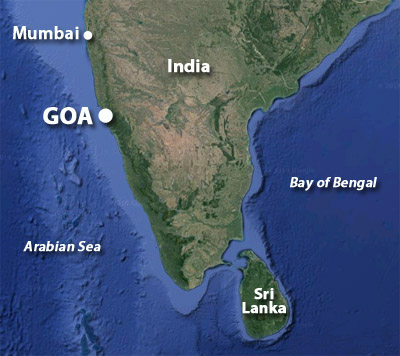 |
|
As was their wont, the Portuguese arrived in a fairly gentle fashion, worked up some trade agreements with the locals, and then figured out a way to capture enough land to build a starfort. In the case of Goa, it took an alliance with Timoji, an Indian freebooter of a nautical persuasion, to defeat the ruling Bijapur Sultan for possession of Goa. But defeated the Sultan was, in 1510. The Portuguese firmly established themselves at Goa with a series of fortifications, which kept their colony secure for the next 450 years.
In addition to the ruling Sultan's displeasure that the Portuguese were present on the coast of his country, the wicked Dutch were forever poking about, with an interest in taking what Portugal had already established (Portugal was, of course, perfectly happy to do the exact same thing to Dutch colonial possessions). To secure their foothold at Goa, the Portuguese built Reis Magos Fort in 1551, where the Mendovi River, which leads into Goa, meets the sea.
|
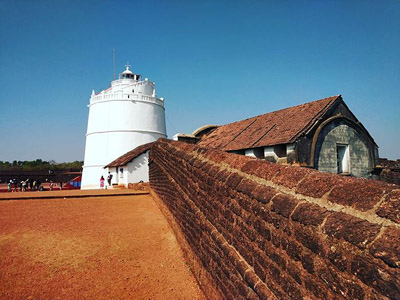 Aguada Fort's most distinctive feature is its four-story lighthouse, which was built in 1864. Aguada Fort's most distinctive feature is its four-story lighthouse, which was built in 1864. |
 |
Ask any 16th-century mariner what commodity was needed most for long-distance oceanic travel. Go ahead, ask him, I'll wait. He said water, didn't he? Reportedly a human can survive for up to three weeks without food (when you're done chatting with the 16th-century mariner, you can ask Mahatma Ghandi (1869-1948) about his experiences with politically-inspired starvation, and he'll tell you he lasted 21 days on a hunger strike, which was not a simultaneous thirst strike), but no longer than a few days without water. Were the mariner with whom you had that neighborly chat to have been Portuguese, he likely would have said água, at least once he got over your strange manner of dress. Água (Aguada means "watery"). See where this is going yet? |
|
|
The Dutch raided the Goa Bar in 1604, too far west from Reis Magos Fort for it have to disuaded such action. Aguada Fort was initiated in 1609, atop the remains of some sort of a lighthouse, to address this issue. Thanks to three freshwater springs that burbled merrily in the vicinity (aguada!), this new fort would also serve as a watering station for parched Portuguese ships. Júlio Simão, Portugal's Chief Engineer in Goa, was responsible for the new fort's design.
In addition to Aguada Fort and Reis Magos Fort, the Portuguese also built the Forte de Nossa Senhora do Cabo (Fort of the Lady of the Cape) and the Forte de Gaspar Dias (Fort of Dave David?!) on the other side of the mouth of the Mandovi River. Nothing seems to be left of those two forts.
|
Aguada Fort consists of two distinct entities, separated by slightly over a mile. The starfort we see at the top of this page is the Upper Fort, and that which we see to the right is the Lower Fort. These two parts of the fort span the peninsula on which they sit, and were additionally protected with a system of walls, bastions and moats. Sources suggest that ship-watering activities took place at the upper fort, and ships were given a safe berth at Sinquerim Beach on the Arabian Sea at lower fort. However! There doesn't seem to be any way that water could have been delivered to ships from the upper fort. If one were to click here, one would see an image of the whole peninsula on which our starfort sits. If you were a mariner, would you wish to get close to the rocky shore near that fort? There is a small jetty sticking out directly to the right of the fort...so it seems likely that there was a jetty or dock near that spot, from which water lighters might supply ships. However it was delivered, Aguada Fort had underground chambers capable of holding 2,376,000 gallons of fresh water, reportedly (and believably) the largest capacity in all of Asia.
|
 |
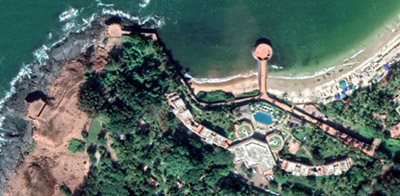 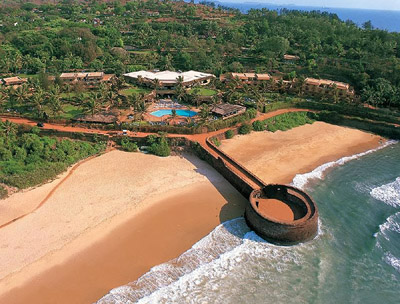 Lower Aguada Fort: A masonry lollipop sticking out into the Arabian Sea. Lower Aguada Fort: A masonry lollipop sticking out into the Arabian Sea. |
|
The Upper Fort of Our Current Interest mounted 79 guns, which was a large number indeed at this time and place. A four-story lighthouse was built within the upper fort in 1864, which operated until 1976. Though 1864 isn't all that long ago by starfort standards (the western world was pretty much done with starforts by 1864), it is nonetheless the oldest such structure in Asia.
Integrated into the upper fort's design was...an escape tunnel. What do you do when the enemy is about to overwhelm your position, or you at least perceive this to be the case? Do you fight to the last man? Hell no you don't, you're not the fricking British! You skedaddle! Dedicated escape tunnels, in my experience, were not terribly common in the design of starforts. A way out, however cleverly hidden, could inevitably become a besieger's way in.
|
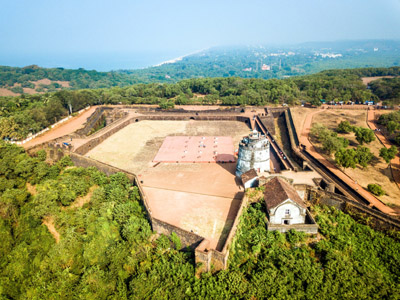 Aguada Fort from the south. Interesting how the southernmost bastion (which is in the foreground) isn't so much a bastion as an observation post! Aguada Fort from the south. Interesting how the southernmost bastion (which is in the foreground) isn't so much a bastion as an observation post! |
 |
The Portuguese had other colonies in India, but by the mid-19th century all that was left to them on the mainland was Goa. This was still a pretty good chunk of land: 1429 square miles, with much the same boundaries that the Indian state of Goa has today.
What happened in the 19th century to eject the Portuguese from the rest of India? The British happened! With the exception of Goa and Pondicherry, an outpost of the French Empire that existed sporadically on India's east coast until 1954, the British Raj extended over all the Indian subcontinent from 1858.
This lasted until 1947, when India had finally become so unpleasant that Britain granted its independence. |
|
|
When Great Britain left India, it encouraged the French and Portuguese to do the same...but those two nations said something akin to, "look, just because you're leaving, it doesn't mean..." The French finally took the hint and left in 1954, but Portugal was another matter entirely.
In the mid-20th century Portugal was enjoying its Estado Novo, "New State," under the benevolent (and dictatorial) hand of António de Oliveira Salazar (1889-1970). One of the Estado Novo's aspects that made it so fun was that it aspired to be an Estado Antigo on the subject of Portuguese Empire: While the rest of the world was dropping its old-timey colonies like so many hot potatoes, Salazar was espousing the benefits of colonialism, and clinging fast to Portugal's overseas possessions.
At some point, the extended, walled-in area we see to the south of Aguada Fort was built (click the image at the top of this page if you don't know what I'm talking about)...and in the days of the Estado Novo, Salazar found this to be an excellent enclosure in which to imprison those who were so rash as to disagree with him.
|
By 1961, India was ready to do something about Goa. The Portuguese who had been living there for 450 years considered Goa to be part of Portugal, but India, and for the most part the rest of the world, felt otherwise. European residents of Goa knew something was coming, and requested instructions from the mothership: Should invasion come, Salazar said, you will fight to the last man. This from a society that builds escape tunnels into its starforts! India's Operation Vinjay (Victory) finally got underway in December of 1961.
|
 |
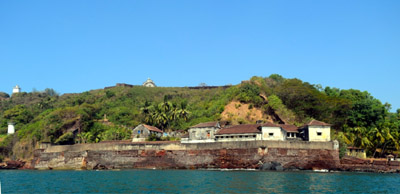 The prison at the foot of Aguada Fort. Sure it sucks to be in prison, but look at the bottom right: How many prisoners are lucky enough to have a garita to play in?! The prison at the foot of Aguada Fort. Sure it sucks to be in prison, but look at the bottom right: How many prisoners are lucky enough to have a garita to play in?! |
|
Two days of land, sea and air attacks on the Portuguese military at Goa, the island of Diu (home of Portuguese forts Diu Fort and Panikota) and a couple of other remaining Portuguese possessions, resulted in 22 Indian and 30 Portuguese deaths... and the ultimate liberation of these colonies. Depending on whose side one was on! The Portuguese naturally considered this to be an affront to its national soil and citizens. Fort Aguada's lighthouse ceased in its primary function in 1976, and lower fort has more recently been gussied up with the Taj Fort Aguada Resort & Spa, which certainly looks like the place I would wish to stay when visiting Goa. The upper fort is open for visitors, and the extended portion at the foot of the fort is still known as Central Jail Aguada. Judging from the online comments of folks who have visited this part of Aguada Fort recently, it appears that the jail is still a restricted area, which can be viewed only through a locked gate...though it has ceased to operate as a jail in recent years.
|
|
|
|
|
|
 |




